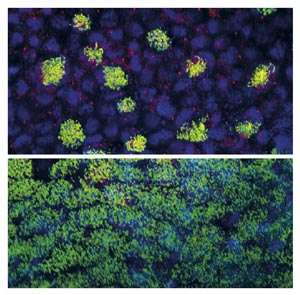Clean sweep for lung cells

A molecule discovered by A*STAR researchers to switch on the formation of brush-like projections on cells may explain how cells lining the airways of lungs develop. This factor, identified in zebrafish and tadpoles, but also present in humans, could shed light on respiratory disease and provide a new therapeutic strategy.
Like tiny brushes, some cells lining our trachea are covered in slender extensions called cilia. Beating rhythmically, cilia sweep out mucus, which traps pollutants from the air we breathe. They also provide the force elsewhere in the body, moving cerebrospinal fluid around the brain and egg cells through a woman's oviducts.
The cells that form cilia rely on proteins called transcription factors to switch on a genetic program. But the factor which prompts cells to grow multiple cilia – rather than just one, such as the single flagellum of a sperm cell – has been elusive.
"The program is quite elaborate and complex – we need a way to explain how the transcription program is regulated in these cells," says Sudipto Roy from the A*STAR Institute of Molecular and Cell Biology, who led the study.
His team discovered a transcription factor called Gmnc is required for multiciliated cell formation in zebrafish and frog embryos. When the scientists inhibited production of Gmnc in these model organisms, fewer or no multiciliated cells formed.
Furthermore, Xenopus tadpoles genetically engineered to produce more Gmnc than normal levels formed more multiciliated cells, suggesting Gmnc has a key role in cilia formation.
The precise mechanisms of how Gmnc regulates gene expression is not understood, as Gmnc itself does not contain a DNA-binding domain and needs to associate with other transcription factors to regulate genes. However, Roy says, Gmnc "seems to have a conserved role from fish all the way to humans."
Roy's team is now investigating whether a defect in the gene encoding Gmnc is involved in a disease called reduced generation of multiple motile cilia, in which patients produce insufficient multiciliated cells to clean their airways and lose lung function. He says discovering a genetic cause for this disease would allow patients to undergo genetic counseling.
Roy is also optimistic about the possibility Gmnc could be used to treat patients that have lost airway cilia through smoking or exposure to heavily polluted air.
"You can think of repopulating a damaged airway by engineering this gene into other cell types and turning them into multiciliated cells," he says. "That's an exciting avenue."
More information: Feng Zhou et al. Gmnc Is a Master Regulator of the Multiciliated Cell Differentiation Program, Current Biology (2015). DOI: 10.1016/j.cub.2015.10.062
Journal information: Current Biology


















